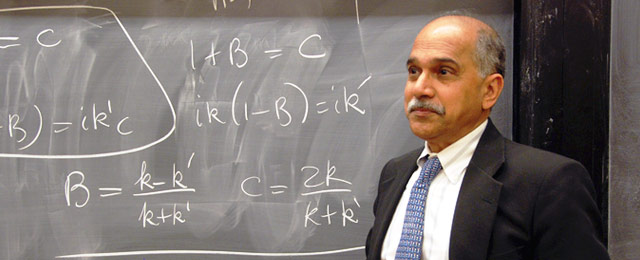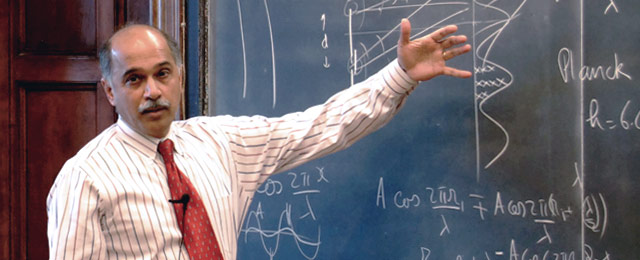Courses tagged with "Calculus I" (77)
Pendulums. Slinkies. You when you have to use the bathroom but it is occupied. These all go back and forth over and over and over again. This tutorial explores this type of motion. Introduction to Harmonic Motion. Harmonic Motion Part 2 (calculus). Harmonic Motion Part 3 (no calculus). Introduction to Harmonic Motion. Harmonic Motion Part 2 (calculus). Harmonic Motion Part 3 (no calculus).
In this tutorial we begin to explore ideas of velocity and acceleration. We do exciting things like throw things off of cliffs (far safer on paper than in real life) and see how high a ball will fly in the air. Introduction to Vectors and Scalars. Calculating Average Velocity or Speed. Solving for Time. Displacement from Time and Velocity Example. Acceleration. Airbus A380 Take-off Time. Airbus A380 Take-off Distance. Why Distance is Area under Velocity-Time Line. Average Velocity for Constant Acceleration. Acceleration of Aircraft Carrier Takeoff. Deriving Displacement as a Function of Time, Acceleration and Initial Velocity. Plotting Projectile Displacement, Acceleration, and Velocity. Projectile Height Given Time. Deriving Max Projectile Displacement Given Time. Impact Velocity From Given Height. Viewing g as the value of Earth's Gravitational Field Near the Surface. Projectile motion (part 1). Projectile motion (part 2). Projectile motion (part 3). Projectile motion (part 4). Projectile motion (part 5). Introduction to Vectors and Scalars. Calculating Average Velocity or Speed. Solving for Time. Displacement from Time and Velocity Example. Acceleration. Airbus A380 Take-off Time. Airbus A380 Take-off Distance. Why Distance is Area under Velocity-Time Line. Average Velocity for Constant Acceleration. Acceleration of Aircraft Carrier Takeoff. Deriving Displacement as a Function of Time, Acceleration and Initial Velocity. Plotting Projectile Displacement, Acceleration, and Velocity. Projectile Height Given Time. Deriving Max Projectile Displacement Given Time. Impact Velocity From Given Height. Viewing g as the value of Earth's Gravitational Field Near the Surface. Projectile motion (part 1). Projectile motion (part 2). Projectile motion (part 3). Projectile motion (part 4). Projectile motion (part 5).
Classical gravity. How masses attract each other (according to Newton). Introduction to Gravity. Mass and Weight Clarification. Gravity for Astronauts in Orbit. Would a Brick or Feather Fall Faster. Acceleration Due to Gravity at the Space Station. Space Station Speed in Orbit. Introduction to Newton's Law of Gravitation. Gravitation (part 2). Introduction to Gravity. Mass and Weight Clarification. Gravity for Astronauts in Orbit. Would a Brick or Feather Fall Faster. Acceleration Due to Gravity at the Space Station. Space Station Speed in Orbit. Introduction to Newton's Law of Gravitation. Gravitation (part 2).
Watch fun, educational videos on all sorts of Physics questions. Bridge Design and Destruction! (part 1). Bridge Design (and Destruction!) Part 2. Shifts in Equilibrium. The Marangoni Effect: How to make a soap propelled boat!. The Invention of the Battery. The Forces on an Airplane. Bouncing Droplets: Superhydrophobic and Superhydrophilic Surfaces. A Crash Course on Indoor Flying Robots.
Work and energy. Potential energy. Kinetic energy. Mechanical advantage. Springs and Hooke's law. Introduction to work and energy. Work and Energy (part 2). Conservation of Energy. Work/Energy problem with Friction. Introduction to mechanical advantage. Mechanical Advantage (part 2). Mechanical Advantage (part 3). Intro to springs and Hooke's Law. Potential energy stored in a spring. Spring potential energy example (mistake in math). Introduction to work and energy. Work and Energy (part 2). Conservation of Energy. Work/Energy problem with Friction. Introduction to mechanical advantage. Mechanical Advantage (part 2). Mechanical Advantage (part 3). Intro to springs and Hooke's Law. Potential energy stored in a spring. Spring potential energy example (mistake in math).
The course will provide an overview of the knowledge acquired during the past 20 years in the domain of exoplanets. It will review the different detection methods, their limitations, and the information provided on the orbital system and the planet itself, and how this information is helping our understanding of planet formation.
Using publicly available data from NASA of actual satellite observations of astronomical x-ray sources, we explore some of the mysteries of the cosmos, including neutron stars, black holes, quasars and supernovae.
Watch fun, educational videos on all sorts of Physics questions. Thomas Young's Double Slit Experiment. Newton's Prism Experiment. Bridge Design and Destruction! (part 1). Bridge Design (and Destruction!) Part 2. Shifts in Equilibrium. The Marangoni Effect: How to make a soap propelled boat!. The Invention of the Battery. The Forces on an Airplane. Bouncing Droplets: Superhydrophobic and Superhydrophilic Surfaces. A Crash Course on Indoor Flying Robots. Heat Transfer. Thomas Young's Double Slit Experiment. Newton's Prism Experiment. Bridge Design and Destruction! (part 1). Bridge Design (and Destruction!) Part 2. Shifts in Equilibrium. The Marangoni Effect: How to make a soap propelled boat!. The Invention of the Battery. The Forces on an Airplane. Bouncing Droplets: Superhydrophobic and Superhydrophilic Surfaces. A Crash Course on Indoor Flying Robots. Heat Transfer.
This is a 12 week course, currently scheduled to start on Monday, April 14, 2014 and finishing on Friday, July 11. This introductory physics course is intended for physical science majors and others desiring a rigorous introduction to physics. It closely parallels the brick-and-mortar course given to the freshmen at the University of Colorado at Boulder. The course covers classical mechanics, including kinematics, dynamics, conservation laws, and applications.
The Origins course tracks the origin of all things – from the Big Bang to the origin of the Solar System and the Earth. The course follows the evolution of life on our planet through deep geological time to present life forms.
An introduction to modern astronomy's most important questions. The four sections of the course are Planets and Life in The Universe; The Life of Stars; Galaxies and Their Environments; The History of The Universe.
This is a continuation of Fundamentals of Physics, I (PHYS 200), the introductory course on the principles and methods of physics for students who have good preparation in physics and mathematics. This course covers electricity, magnetism, optics and quantum mechanics.
This course will cover various topics on the discoveries about how the Universe evolved in 13.7 billion years since the Big Bang.
This course provides a thorough introduction to the principles and methods of physics for students who have good preparation in physics and mathematics. Emphasis is placed on problem solving and quantitative reasoning. This course covers Newtonian mechanics, special relativity, gravitation, thermodynamics, and waves.
This course provides a thorough introduction to the principles and methods of physics for students who have good prepara
8.962 is MIT's graduate course in general relativity, which covers the basic principles of Einstein's general theory of relativity, differential geometry, experimental tests of general relativity, black holes, and cosmology.
This class is an introduction to classical mechanics for students who are comfortable with calculus. The main topics are: Vectors, Kinematics, Forces, Motion, Momentum, Energy, Angular Motion, Angular Momentum, Gravity, Planetary Motion, Moving Frames, and the Motion of Rigid Bodies.
This Stanford Continuing Studies course is the second of a six-quarter sequence of classes exploring the essential theor
This freshman-level course is the second semester of introductory physics. The focus is on electricity and magnetism. The subject is taught using the TEAL (Technology Enabled Active Learning) format which utilizes small group interaction and current technology. The TEAL/Studio Project at MIT is a new approach to physics education designed to help students develop much better intuition about, and conceptual models of, physical phenomena.
Staff List
Visualizations:
Prof. John Belcher
Instructors:
Dr. Peter Dourmashkin
Prof. Bruce Knuteson
Prof. Gunther Roland
Prof. Bolek Wyslouch
Dr. Brian Wecht
Prof. Eric Katsavounidis
Prof. Robert Simcoe
Prof. Joseph Formaggio
Course Co-Administrators:
Dr. Peter Dourmashkin
Prof. Robert Redwine
Technical Instructors:
Andy Neely
Matthew Strafuss
Course Material:
Dr. Peter Dourmashkin
Prof. Eric Hudson
Dr. Sen-Ben Liao
Acknowledgements
The TEAL project is supported by The Alex and Brit d'Arbeloff Fund for Excellence in MIT Education, MIT iCampus, the Davis Educational Foundation, the National Science Foundation, the Class of 1960 Endowment for Innovation in Education, the Class of 1951 Fund for Excellence in Education, the Class of 1955 Fund for Excellence in Teaching, and the Helena Foundation. Many people have contributed to the development of the course materials. (PDF)
Trusted paper writing service WriteMyPaper.Today will write the papers of any difficulty.






















